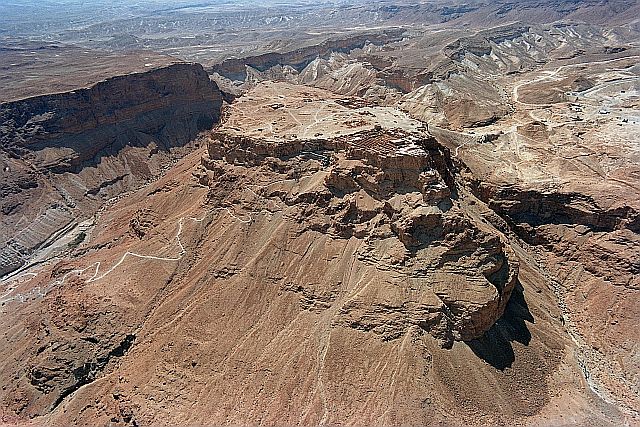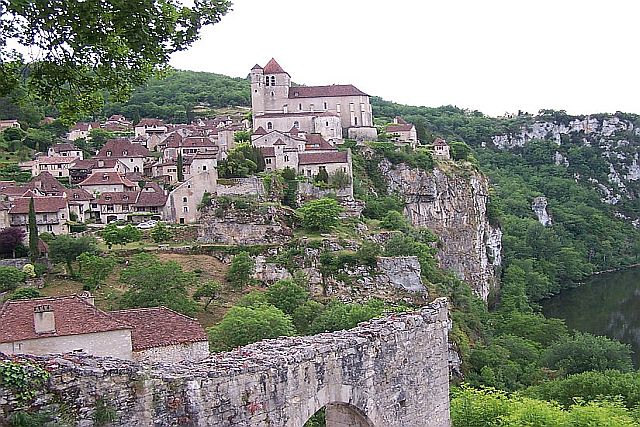 |
| The Masada Plateau with the Snake Trail in the background -- Jews held off Roman legions for 3 years (wikipedia) |
But there is another site in
Israel that should be on every visitor’s must-see list. Masada is an ancient
fortress situated on the crest of an isolated plateau overlooking the Dead Sea.
 |
| Masada's desolate ruins are impressive (Taylor) |
Located at the eastern edge
of the Judean Desert, it was at Masada that a band of approximately 960 Jewish
Sicarii rebels held off the Roman army for three years before being breached in
73 AD.
Like so much of the historical
accuracy in the Holy Land, Masada is the subject of considerable architectural
debate, but there can be no question about the existence of fortress itself, and
therein lies much of its appeal.
Much of the controversy
centers around the accounts of a 1st-century Jewish Roman historian named
Josephus who is responsible for nearly all the written information about the
story of Masada. The problem arises in the fact that most scholars regard
Josephus as a less than reliable source for the details surrounding Masada.
 |
| Model of Herod the Great's three tiered palace which he never occupied (Taylor) |
Masada sits atop a 1,400-foot
desert plateau that spreads over an area of 23 acres. Though never occupied by
Herod the Great, he built a palatial villa there on three descending terraces
at the northern end of the rock. Due to the angles, there are only partial
views of the palace from above.
In 2001, Masada became a
UNESCO World Heritage Site which can be reached by walking up the Snake Trail
from the Dead Sea side, by the Roman Ramp Trail on the western side or by cable
car.
According to Josephus, the
Sicarii were an extremist group that split from a larger Jewish assembly known
as the Zealots. They fled Jerusalem in 70 AD and settled at Masada after the
massacre of a Roman garrison.
 |
| Water was a key factor in Masada's survival (wikipedia) |
The governor of Rome pursued
the Sicarii and surrounded Masada but were stalled in their siege due to the
strategic location of the fortress. Thanks to an ingeniously designed system of
cisterns, the Jews often taunted their enemies by drenching them with fresh
water in the severe desert heat of the region.
Eventually, the Romans began
constructing a circumvallation wall and then a siege ramp against the western
face of the plateau. Construction of the ramp was frequently stopped because
the Jewish defenders were able to pelt the Romans from above with rocks.
In the end, the Romans
succeeded by using Jewish captives to build the ramp. The Sicarii halted their
stone bombardments in order to keep from killing their brethren.
After three long years, the
Roman legion eventually breached Masada and captured the fortress. Upon their
arrival however, the Romans discovered that most of the 960 inhabitants were dead and all the buildings
except for the food storerooms had been burned. Only a handful of women and
children survived
 |
| Partial view from above of Herod's palace at Masada as it exists today (Taylor) |
.
Whether the Jews committed
mass suicide remains a topic for conjecture. Other details that have proven to
be either inaccurate or ommitted is also subject to scholarly debate.
 |
| The Snake Path was the primary access point to the Masada Fortress (wikipedia) |
What is known however, is
that the elaborate system of channels that provided an ample water supply for
the inhabitants does exist, as do the remnants of Herod’s northern villa. The
siege did take place and the defenders were dead when the Romans entered the
fortress.
 |
| A cable car is the fastest, easiest and most efficient way to reach Masada (wikipedia) |
As the debate continues, so
does the symbolism of Masada in modern-day Israel. For Jews, Masada is a sign
of unity against its adversaries. The site was regarded as so significant that
the former Israeli military leader, Moshe Dayan, initiated the practice of
holding swearing-in ceremonies for various units of the Israel Defense Forces (IDF)
at Masada.
Over time the practice has
been somewhat displaced, but Israel’s paratroopers still commemorate the Six
Day War of 1967 at the Western Wall of Masada.
 |
| The Masada plateau is a symbol of determination and pride for Israel (wikipedia) |
Like so many places
throughout the world, Masada is a site that much be visited in person to
understand the full magnitude of its meaning.
For Americans Masada is, in
its own way, much like the Battle of the Alamo. For Jews, given the historical
chronology, they would likely tell us that the Alamo is more like Masada.
Like so many sites in the
Holy Land, archaeology often creates more questions than answers. Whatever the
truth may be about Masada however, cannot be diminished by a lack of
information because the site speaks for itself.
This article first appeared in Communities Digital News
For more travel stories and exciting tour opportunities visit Magellan Travel Club



































